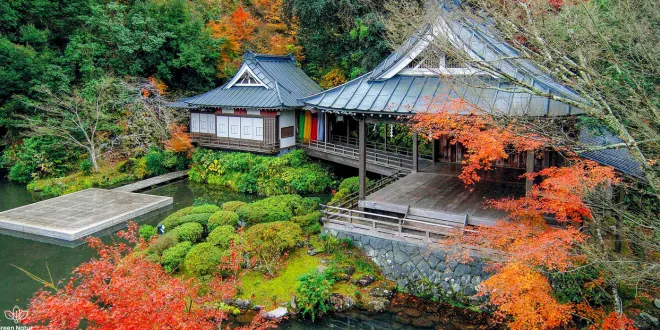Ryokans, the best-kept gems of Japanese hospitality, offer a perfect balance of tradition, comfort, and cultural immersion. These iconic inns provide guests with a truly authentic Japanese experience, complete with tatami-mat rooms (washitsu) and relaxing onsen hot springs—key features that define the charm of the best ryokans in Japan.
As the year draws to a close and Japan slows down for the holiday season, ryokans become popular sanctuaries for peaceful reflection and renewal. Many travelers choose this time to unwind, soak in natural hot springs, and witness Japan’s stunning winter landscapes, including the symbolic first sunrise of the year.
To help you explore the most exceptional places to stay, we’ve carefully selected six of the best ryokans in Japan—each offering a unique, immersive stay that captures the heart of Japanese tradition.

Tachibana Shikitei
Nestled in the heart of Kaga City, Tachibana Shikitei invites guests to step into the elegance of the Meiji era. As one of the best ryokans in Japan, it showcases a rich historical charm through its serene gardens, antique décor, and peaceful tatami rooms that reflect timeless Japanese aesthetics.
Guests are treated to the exquisite tradition of kaiseki dining—a seasonal, multi-course culinary journey crafted from locally sourced premium ingredients. Once enjoyed exclusively by nobility, this dining style reflects the spirit of omotenashi, Japan’s signature approach to gracious and attentive hospitality. For an unforgettable stay, opt for a suite featuring a private onsen bath.
Conveniently located just 30 minutes by car from Komatsu Airport, Tachibana Shikitei also offers a complimentary pick-up service from Kaga-Onsen Station, a mere 10-minute drive away—ensuring a seamless and stress-free arrival.
Yunoshimakan
Perched atop a scenic hill overlooking the picturesque hot spring town of Gero, Yunoshimakan stands out as one of the best ryokans in Japan. Whether you’re unwinding in the serene open-air baths or enjoying the peaceful privacy of an indoor soak, your complimentary yukata (traditional bathrobe) sets the tone for a truly personalized and rejuvenating onsen experience.
In winter, the ryokan is often cloaked in snow, enhancing the charm of the surrounding Hida landscape and offering breathtaking views of the mountains and river. The area comes alive with opportunities to immerse yourself in Japanese culture—from tea ceremonies and kimono dress-up to seasonal events that celebrate timeless traditions.
Beyond the ryokan’s tranquil embrace, a short 6-minute drive takes you to the lively Ideyu Morning Market or the enchanting Gassho Village (Gero Onsen Gassho Mura). This open-air museum features steep-roofed gasshozukuri farmhouses from the Shirakawago region, where visitors can explore interiors, enjoy cultural performances, or try their hand at traditional folk crafts.
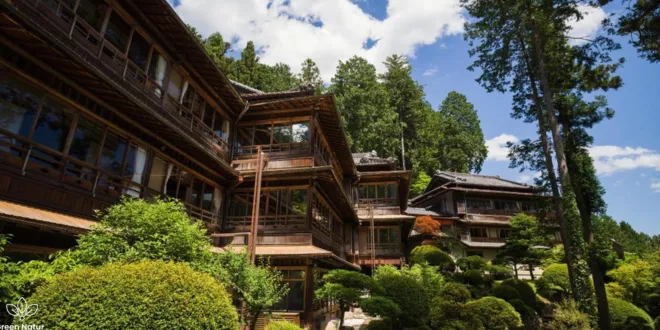
Hamachidorinoyu Kaisyu
If your soul is drawn to water, Hamachidorinoyu Kaisyu in Wakayama Prefecture promises an unforgettable stay. Overlooking the vast Pacific Ocean, this hidden sanctuary is one of the best ryokans in Japan, seamlessly combining oceanic beauty with the refined art of Japanese hospitality. Its mineral-rich onsen baths offer the ultimate way to unwind while taking in sweeping seaside views.
The ryokan’s warm, wood-paneled rooms come thoughtfully equipped with modern comforts such as a TV, refrigerator, humidifier, hairdryer, and safe. Guests can indulge in a relaxing massage on request or simply enjoy a moment of serenity with a complimentary plum juice at Lounge Shiraho.
Beyond the ryokan, Wakayama invites exploration. A two-hour scenic drive leads to the ancient Kumano Kodo pilgrimage trails—a UNESCO World Heritage site offering a spiritual journey through Japan’s sacred forests. Don’t miss the striking Kumano Hayatama Taisha Shrine, located where the Kumano-gawa River meets the sea. Continue your nature-infused adventure into the lush Nachi Primeval Forest, home to the breathtaking 436-foot Nachi Falls—the tallest waterfall in Japan.
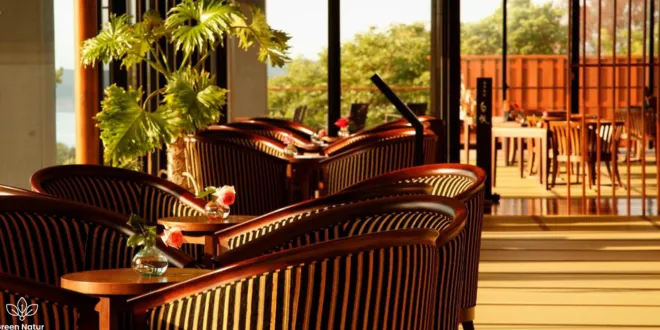
Zaborin
Tucked away near the snow-dusted peaks of Mount Niseko Annupuri in Hokkaido, Zaborin offers a serene escape where modern design meets timeless tradition. As one of the best ryokans in Japan, this luxurious retreat blends minimalist elegance with classic comforts—featuring private onsen baths, traditional Japanese breakfasts, and daily kaiseki dinners crafted with precision and artistry.
Zaborin’s exceptional service sets it apart. Guests consistently praise the attentive and gracious staff, with one remarking, “They go out of their way to make you feel welcome. The dinner was the best dining experience I’ve ever had—perfect in every way, from presentation to taste.”
Between soothing soaks in your private onsen, venture out to nearby Niseko Village for world-class skiing and breathtaking alpine scenery, making Zaborin not just a stay, but a destination in itself.
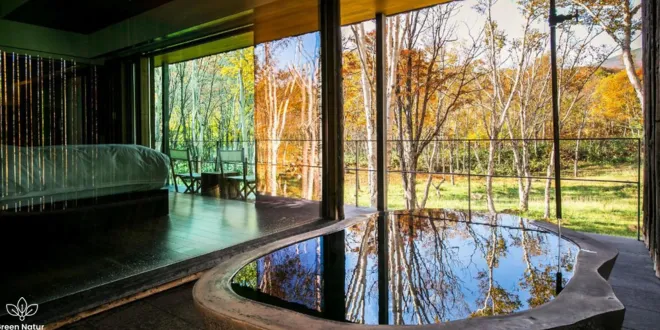
Sui Suwako
Nestled along the serene shores of Lake Suwa in Nagano Prefecture—often called “the belly button of Japan”—Sui-Suwako offers an intimate escape into nature and tradition. As one of the best ryokans in Japan, this boutique property redefines the luxury experience with just eight exclusive rooms, each featuring a private onsen and in-room dining, all set against the breathtaking backdrop of Lake Suwa.
The name “Sui” reflects the flourishing beauty of nature and a commitment to meaningful human connection and personal renewal. This philosophy is woven into every element of the guest experience, from the tranquil atmosphere to the warm, personalized service.
Sui-Suwako is also proudly eco-conscious, holding Travel Sustainable Level 2 status. Guests here actively help reduce their carbon footprint—with approximately 15 kg of CO₂ offset during each stay. As a meaningful gesture, the ryokan offers an “Offset STAY Certificate” and a complimentary drink with dinner.
For those eager to explore the rich culture of the region, Sui-Suwako’s sister property, Kamisuwa Onsen Shinyu, invites guests to join the free Shinyu Go tour bus. Led by knowledgeable driver-guides, this experience takes you to all four revered Suwa Taisha shrines—an enlightening journey into the spiritual heart of the region.

Onyado Shikishima-kan
Perfectly suited for a family getaway, Onyado Shikishima-kan offers a relaxing yet exciting retreat just 15 minutes from the lively New Reoma World amusement park. As one of the best ryokans in Japan for families, it combines thoughtful amenities with warm hospitality to create a stay that’s as comfortable as it is memorable.
Guests enjoy complimentary WiFi, a 24-hour front desk, and convenient lift access throughout the property. The elegantly furnished rooms include air conditioning, flat-screen TVs, and safety deposit boxes, while select rooms offer private terraces—perfect for unwinding after a day of adventure.
Start your day with a traditional Japanese breakfast before making the most of the ryokan’s wellness offerings, including a serene onsen, rejuvenating sauna, and relaxing spa facilities.
When you’re ready to explore beyond the property, cultural landmarks like Kotohiragu Shrine and the beautiful sunset views at Chichibugahama Beach—just a 30-minute drive away—provide the perfect blend of nature and heritage.
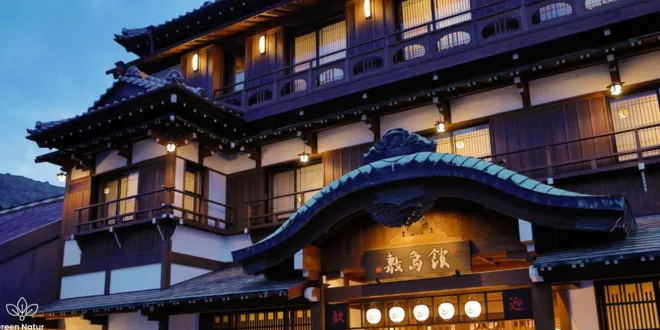
Conclusion
In every corner of Japan—from the snowy mountains of Hokkaido to the tranquil lakes of Nagano and the sunlit shores of Wakayama—ryokans offer a unique window into the heart of Japanese culture. Whether you’re a solo traveler seeking serenity, a couple in search of romance, or a family looking for bonding moments, the best ryokans in Japan provide more than just a place to sleep—they deliver an immersive, soul-soothing experience rooted in centuries of tradition.
Each of the ryokans we’ve featured stands out for its thoughtful design, exceptional service, and authentic touches that make your stay unforgettable. From private onsen with sweeping views to multi-course kaiseki dining crafted with seasonal ingredients, these properties exemplify the very best of what Japanese hospitality—omotenashi—has to offer.
If you’re planning your next getaway and looking for a balance of luxury, peace, and cultural depth, choosing from the best ryokans in Japan is the perfect way to reconnect with yourself and the beauty of the world around you.
So, whether it’s for a winter retreat, a cultural journey, or a wellness escape, let the best of Japan welcome you—one ryokan at a time.
FAQs
1- What is a ryokan in Japan?
A ryokan is a traditional Japanese inn featuring tatami-mat flooring, futon beds, and often includes onsen baths and multi-course kaiseki meals.
2- Why choose a ryokan over a hotel in Japan?
Ryokans offer an authentic cultural experience, personalized hospitality, and a peaceful atmosphere that hotels typically don’t provide.
3- What makes the best ryokans in Japan stand out?
The best ryokans in Japan combine exceptional service, traditional aesthetics, gourmet cuisine, and luxurious private or shared onsen facilities.
4- Are ryokans suitable for families with children?
Yes, many ryokans are family-friendly and offer amenities for children, including kid-friendly meals, larger rooms, and fun nearby activities.
5- Do all ryokans have onsen (hot springs)?
While many do, not all ryokans have onsen. The best ryokans in Japan often feature either shared or private onsen baths with scenic views.
6- Is it necessary to speak Japanese at a ryokan?
Not necessarily. Many top ryokans have English-speaking staff or offer support in English to assist international guests.
7- How much does it cost to stay at one of the best ryokans in Japan?
Prices vary depending on location, season, and amenities. Luxury ryokans can range from $200 to over $1,000 per night per person.
8- What should I wear at a ryokan?
Guests are typically provided with yukata (a casual kimono-style robe) to wear during their stay, especially to meals and the onsen.
9- Do ryokans offer vegetarian or special dietary options?
Many high-end ryokans accommodate dietary restrictions with advance notice. It’s best to inform them during booking.
10- When is the best time to stay at a ryokan in Japan?
Ryokans are wonderful year-round. Winter is ideal for enjoying hot springs with snowy views, while spring and autumn offer beautiful seasonal scenery.

